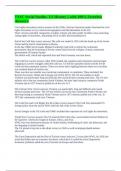TASC Social Studies- US History || with 100% Errorless
Answers.
Civil rights movement correct answers In the 1950s, African American leaders launched the civil
rights movement to try to end racial segregation and discrimination in the US.
Their victories included: integration of public schools and other public facilities, laws protecting
voting rights of minorities, and getting rid of racially discriminating laws.
End of the Cold War correct answers The cold war ended in 1991 with the break up of the Soviet
Union and the end of communism in Russia.
In the late 1980s Soviet leader Mikhail Gorbachev had tried to reform the communist
government. But the loosening of Soviet control had led to the collapse of many communist
governments of Eastern Europe.
The Berlin wall, which had separated East and West Germany was torn down.
The Cold War correct answers After WW2 ended, the capitalist and communist nations began
engaging in a power struggle called the cold war. US led the capitalist nations and the Soviet
Union led the communist nations. There was never direct fighting between these two, but there
was constant threat of nuclear war.
There was also two smaller wars involving communism vs capitalism. These included: the
Korean War (early 1950s) and Vietnam war (1954-1975). The US sent soldiers to both.
Vietnam was particularly long and difficult and caused division among americans. The US sent
military aid to the non communist South Vietnam, but they kept losing to communist North
Vietnam and in 1973 America pulled out of the war. In 1
The Vietnam War correct answers Vietnam was particularly long and difficult and caused
division among americans. The US sent military aid to the non communist South Vietnam, but
they kept losing to communist North Vietnam and in 1973 America pulled out of the war. In
1975 the communists took over Vietnam.
The Cold War and Civil Rights Era Key Ideas correct answers The Cold War dominated US
foreign policy from the end of WW2 until the fall of the Soviet Union.
Social changes in the US in the mid 1900's included the expansion of civil rights for minorities,
World War 2 correct answers The US entered WW2 after they were bombed at Pearl Harbor by
the Japanese. Americans fought in Europe, Africa, and Asia.
WW2 was very destructive because of violent battles, firebombing of cities, the holocaust, and
the dropping of atomic bombs.
The US played a big role in the allied victory in 1945 as well as helping rebuild nations
afterward.
The Great Depression and the Rise of Facism correct answers 12 years after WW1, by 1929, the
world had fallen into an economic downturn, which the US called the Great Depression.
Economic problems aided the rise of fascism in Europe and elsewhere.
, Germany, led by Hitler, started attacking smaller nations in Europe in the mid 1930's.
Italy fought to takeover Ethiopia in Africa, and Japan attacked China.
Hitler built an alliance with Italy and Japan called the axis.
By 1939, war broke out between the axis and the allies.
World War 1 correct answers WW1 began in Europe in 1913. It was the Allies: Great Britain,
Russia, and France, against the Central Powers: Germany, Austria-Hungary, and the Ottoman
Empire.
They fought for three years in a stalemate. Then, in 1917, the US was alarmed over Germany
sinking American ships, and joined the allies.
With US help, the allies won WW1 in 1918.
US Imperialism correct answers Expansion of US industries in the mid 1800s led to imperialism.
Business and government leaders wanted access to more natural resources so that industries
could keep growing. They also wanted to be able to sell more goods overseas.
Regions in Africa , Asia, and Latin America had rich natural resources and potential markets of
people who might want to buy American goods.
To promote industrial growth and increase its power, the US became imperialistic.
Imperialism correct answers Imperialism is the policy by which a stronger nation extends
economic, military, and/or political control over a weaker nation or region.
US Imperialism cont. correct answers The US got involved in imperialism in the late 1800s.
In 1898, the US fought in the Spanish-American War. They declared war because of Spain's
mistreatment of Cuba, a Spanish colony. Yet, after winning the war, the US took over Spain's
colonies of Cuba, Puerto Rico, the Phillipines, and Guam and gave none of them independence.
The US as an emerging world power key ideas correct answers Industrialization spurred US
interest in gaining access to the raw materials and markets of other countries.
The US pursued imperialistic policies in the late 1800s.
The US entered both WW1 and WW2 on the side of the allies and contributed to them winning
both wars.
Reformers and the progressive era correct answers Many reformers were working to solve
problems caused by industrialzation. These included: cleaning up slums, improving health care,
stopping child labor, creating national parks, and giving more people a voice in the government.
For example, many women lobbied to gain the right to vote.
In the early 1900s groups were working towards so many social and political improvements that
the time is called the progressive era.
Factory Workers, Unions, and Strikes correct answers Factory workers worked long hours for
little pay and did hard, dangerous work.
Overtime, workers began to unionize. By joining a union, workers pledged to work together to
get better, safer working conditions and higher wages. They called strikes when employers cut
their pay or refused to grant raises.




